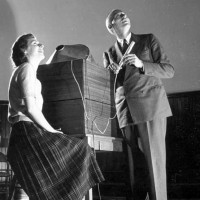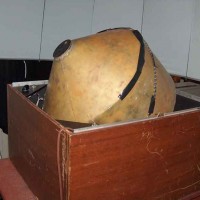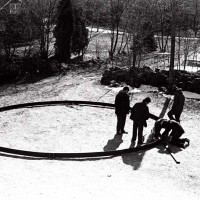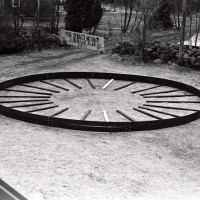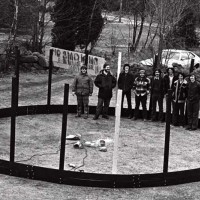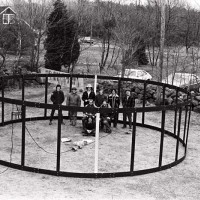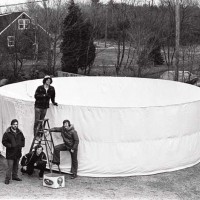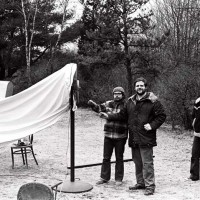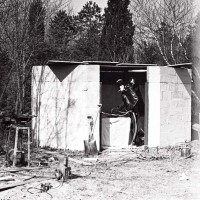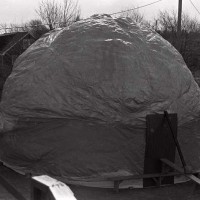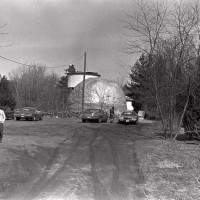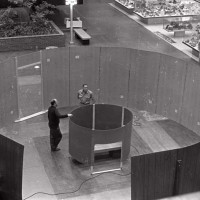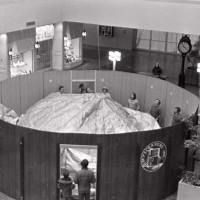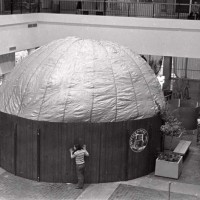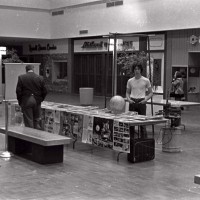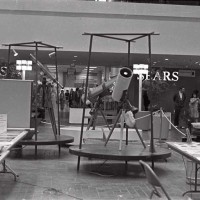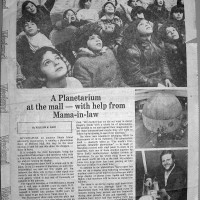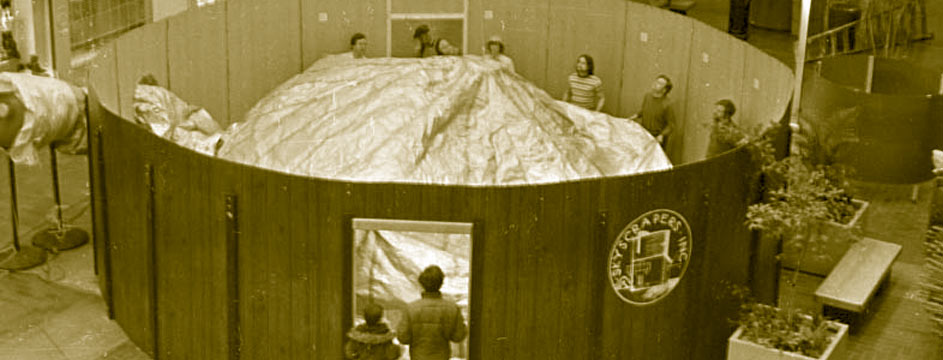
Skyscrapers Portable Planetarium Project
February 2005 :
In my capacity as Skyscraper historian during the past couple of decades, I have endeavored to enlighten members, both old and new, about the rich history of our society. From Frank Seagrave’s 16th birthday gift of an 8-inch Alvan Clark refractor to the founding of Skyscrapers on May 5, 1932 by Professor Charles Smiley of Brown University, to the incorporation of our organization on November 17, 1936, through many eclipse expeditions and countless public nights, to thousands of people waiting at our telescopes to catch a glimpse of Halley’s Comet, our continued success can be traced back to a series of events that could have resulted in quite a different outcome.
Where am I going with this train of thought? Think about your own lives. How many times have you come to one of those proverbial “forks in the road” when your decision may not only have changed your life, but also others as well? We’ve all met here at Skyscrapers through a series of random (hopefully) events. But what if during the past hundred years or so there were one or two “nexus” events that most likely would have changed many of our lives?
One major nexus that concerns all of us can be gleaned from a letter Frank Seagrave wrote to Harvard University’s Professor E.C. Pickering on October 19, 1903. In it Frank writes, “Do you know of anybody that would like to buy an 8-inch equatorial telescope? I would like to sell mine if I could get a reasonable price for it. I thought that I would write to you before placing it in A. Clark & Sons hands to sell. The telescope has clockwork, micrometer, two sets of eyepieces …”
On November 2, 1903, Pickering replied, “I regret that I know of no one who wants an 8-inch telescope, and can think of no better course to follow than to communicate with the Clarks, unless possibly to advertise in Popular Astronomy.”
To this day I don’t know what prompted Seagrave to offer his telescope up for sale. The above reference is the only one I have found that mentions the matter. Thank goodness Harvard didn’t find a use for it. This seemingly innocent event could have changed all our lives. I don’t dwell on issues like this. I don’t believe in pre-determination. Events happen randomly, driven by the free will of our associates. But it is fun to speculate.
Well, Frank did decide to keep his telescope. Eventually he moved it up to Scituate on Peeptoad Road in 1914 to escape the coal dust and gas lamps that plagued his observations in Providence. Frank continued to observe from the dark skies of Scituate until his death on August 15, 1934. The observatory then became the property of his cousin, Walter F. Angell of Providence, with whom Frank had spent his final years.
It wasn’t until Mr. Angell passed away almost two years later in 1936 that Skyscrapers learned that Frank E. Seagrave’s observatory was for sale. Skyscrapers, then four years old, thought it would make a nice home for the group. So, they decided to incorporate as Skyscrapers, Inc, The Amateur Astronomical Society of Rhode Island, and their first order of business was to purchase the observatory and grounds from the Angell estate. If you read a copy of the highlights of our first 25 years entitled, A Quarter Century of Skyscraping on our web site, you can view the list of charter members.
These charter members continued to run the organization for many years, remaining a very close-knit group. They really thought of it as more of a social club, and I believe they were very selective as to who they elected to membership. Though the by-laws allowed for junior members, they were not on an equal footing nor were they allowed access to the instruments. This fact is crucial to our story as the years went on.
In the middle to late ‘60s the “old guard,” many of them charter members, had retired and were passing away. The observatory fell into a state of disrepair and major upkeep was lacking. The observatory was falling apart. Membership in Skyscrapers was at a decline.
Two very active astronomy groups in the state at the time were RIMRO (Rhode Island Meteor Research Organization) and RISS (Rhode Island Stellar Society). These groups, comprised mostly of younger individuals, became junior members of Skyscrapers who were allowed to use the observatory meeting hall for meetings and the grounds for observing, but were not permitted access to the equipment. When these groups eventually disbanded, many of these disenfranchised folks remained members of Skyscrapers, due largely to the new leadership of Ed Turco and Dave Armitage.
Junior members had generally been shunned by the “old-guard” who was reluctant to relinquish control of the organization they had built and maintained over the years. However, their lack of openness was actually causing the organization to stagnate. There had never really been a push for new membership. Skyscrapers was indeed fortunate that interested individuals discovered the society on their own initiative.
There were several notable exceptions to the “old guard” closed-mindedness. Rick Lynch and Dave Armitage independently reported to me that Dorothy and Harvey Harkins were particularly helpful to the younger members. These long time members mentored and trained many of the younger set on the use of the 81/4-inch Alvan Clark refractor. Dave stated they “were not original older members but joined later. I can’t say enough about the support of Harvey and Dora – great people, and critical to the successful organization that Skyscrapers is today.”
Another notable exception recalled by Dave was “Rev. Phillip Kierstead, who gave us keys to the observatory, although not authorized by the membership or the trustees. He felt, probably correctly, that we would never be deemed worthy of access to the equipment, despite the fact it was really not being used at all. He understood, I think, that Skyscrapers would live or die based on our continued participation, and that we were getting frustrated at having a beautiful instrument just out of reach.”
It is my understanding that the older faction actually considered selling the assets of the society “and doing something worthy with the money” as Dave Armitage phrased it, and disbanding Skyscrapers as well. What a selfish perspective! Since they were dying, the society should suffer the same fate.
This period is the beginning of the next “nexus” for Skyscrapers. Though Frank Seagrave’s contemplation of selling the Clark refractor was a single event that would have altered all our lives, the late ’60s and early ‘70s timeframe in Skyscrapers history also provided several opportunities for circumstances to have taken a different path.
Luckily, at a time when it was needed most, those former members of RIMRO and RISS were able to gain the respect of the remaining active members of the “old guard.” Some of these newer members were even subsequently elected to office, namely Ed Turco and Dave Armitage. The “old guard” really had no choice. If the society was going to survive, they had to let go and let the next generation assume the responsibility they had aspired to over the years! A rejuvenated membership began to turn Skyscrapers around. I believe we owe much to those individuals who, despite some opposition to their ascension to power, began that road to recovery that today, reaps so many benefits.
Once this next generation of Skyscrapers began to run the society, there was a lot of recovery work to do. The property had fallen into some disrepair. But the topic that was frequently raised at monthly meetings during the early 1970s was that of declining membership. Unfortunately there seemed little interest in addressing this pressing problem. The only person interested in creating a solution was Dave Armitage.
Dave was not new to Skyscrapers. He joined sometime in the ‘60s. Dave was a retired Air Force captain who liked to do things in a big way. He was elected President for the 1972-1973 term. As Dave accepted the gavel from President John Bacon (1971-72), part of his inaugural acceptance speech was thusly paraphrased in the May 5, 1972 monthly meeting secretary’s report: “Dave spoke briefly about the past 40 years of Skyscrapers and told about plans for a membership drive so the club can grow, prosper, and achieve during the next 40 years.”
Sometime between his inauguration and the fall of 1974, Skyscrapers held a monthly meeting at Brown University’s Metcalf Chemistry Lab. After a presentation by Dr. Ed Brooks of Boston University (and a Sky and Telescope editor as well), the group was invited across the street to see Brown’s homemade planetarium that was set up on the second floor. (At this time I cannot confirm the date of this meeting. The monthly minutes are incomplete.) The room had a domed ceiling and the group was given a demonstration of the projector. Rick Lynch recalls that he was sitting with Dave Armitage. Sometime during the presentation Dave leaned over and said that Skyscrapers should borrow the star projector and present planetarium shows on a bigger scale at the observatory. Rick recalls they actually discussed building a permanent planetarium at Seagrave!!
Well, the seed of that idea was firmly planted in Dave’s head, and that was the start of the adventure. I’m sure Dave pondered the planetarium idea for some time. In May 1974, Ed Turco was elected President of Skyscrapers, with Dave Armitage appointed trustee soon thereafter (at least by the July 5, 1974 monthly meeting,) to fill a vacancy left by Neil Paulhus. During the fall of 1974, Dave presented his idea to the membership that the society should construct a portable planetarium to be hopefully erected at one of the local malls with the use of Brown’s star projector. As Rick Lynch recalls, “The Mall was grand at the time and Dave had grand ideas for Skyscrapers.” We would get great publicity for Skyscrapers, plus it would help attract new members.
There was no task too big or complex to tackle for Dave Armitage. During his term as trustee, Dave was the driving force for many of the projects that came to fruition during 1975, including the inauguration of our monthly newsletter, The Skyscraper. For a while Dave composed the newsletter using the typesetting facilities at Rhode Island College where he worked. Later it was mimeographed copies until the early ‘80s. He also rigged an alarm system for the observatory and motorized the drive for the Clark refractor.
Dave Armitage presented the portable planetarium proposal to the management of the Midland Mall (now the Rhode Island Mall) who were truly excited about the project. The mall manager presented the idea to the mall’s Merchants’ Association at a January 9, 1975 monthly meeting. He reported that the merchants liked the idea, noting that nobody else had done anything like this in the state before. Negotiations continued for a short while and finally Skyscrapers were given the go-ahead. The mall looked on the effort as something to boost traffic during a “slow” period of the year, so they booked the planetarium for a week in April (the week before school vacation, I believe) which was traditionally their slowest week of the year. As Dave recalled, “It was the first and only place we had asked. Fortunately it was a two storied mall. We definitely needed the height in order to inflate the dome.”
“Under the arrangement worked out with the mall, we will charge 10 cents per person admission to the planetarium. Any difference between what we collect and our expenses in building the inflated structure will be made up by the mall. If we collect in excess of our expenses, it’s ours to keep, although we would have to run about 2,000 persons through our show for that to happen! Such a thing, however, is by no means impossible – especially if we create a dynamite show that gets talked about by people that see it!” (Dave Armitage, from the February, 1975 issue of The Skyscraper, Vol 1, No. 2)
The project was well under way during January, 1975. Dave said, “We are certainly biting off a big one this time … I hope it’s not too much. But I don’t think it is! We have a really energetic society now, thanks especially to the relatively new members. With their help, I think we can put on the best show that mall’s ever seen!”
Dave worked out the design of the structure, a 25-foot ring substructure with walls, with a canvas fabric (obtained by Chet Siok from Cooley’s Inc, awning makers for whom he worked) cut in triangular panels that were sewn together. Dave wrote a program for the IBM 360 to calculate the exact shape and dimensions of the 12 fabric panels that formed the dome. “We took the computer-generated measurements and used them to draw the pieces that would be sewn together,” Dave recounted. “We then had to cut the things out, which was not easy task – the canvas wasn’t that easy to cut, not to mention sew! When we were done, it was pretty close to a true hemisphere.” (I personally recall remember visiting the Siok’s to help cut the fabric panels in their basement. Yes folks, believe it or not, their basement actually had room to accomplish that task in those days.) Once the panels had been cut they had to be sewn together to form dome. This daunting task was taken on by Kathy Siok’s mom. I don’t know if I was aware if it at that time or not, but Kathy’s mom was quite ill. In fact, Kathy’s dad had to finish the sewing project.
Once the dome was completed, it was time to paint it. Chet Siok also procured the paint for this project, a metallic methyl ethyl ketone that smelled terrible. A simple task you might think. Unfortunately the canvas material was very porous and it soaked up paint like a sponge. It needed several coats, not only to make it light tight, but also to make it air tight! Otherwise it would not inflate!! The first couple of coats were done at Seagrave.
This paint was a solvent-based aerosol paint which caused the painters to feel “high” and also sick on the fumes it produced. Rick Lynch came to the rescue and let us borrow his scuba diving equipment, with mask and air tanks, to apply a couple of coats of the paint. This procedure really became unmanageable and was abandoned.
The dome was thought to be uniformly painted, but we would later find out that there were excessive pinholes across a wide section of the dome. It ended up that we used these “points of light” to portray the Milky Way during our program
While we were halfway through the painting at Seagrave, a windstorm came up over night and knocked the dome down. We were able to salvage most of it. This obviously happened twice. In the April 1975 issue of The Skyscraper (Vol 1, No. 4), Dave Armitage reported, “The wind made it impossible to paint, wrecked our first framework, and partially destroyed our second framework! It wouldn’t even be consistent enough to warn us when we were going to have trouble – it would be a beautifully calm day, we would have the framework 80% complete, and along would come this sudden gust out of nowhere and crunch!”
The dome was inflated by two big fans that Steve Siok had borrowed from St. Adalbert’s church, where he had been an altar boy many years before. They worked great. The exit signs were lit by some gadget Dave Armitage had found useful. People were amazed at whatever the technology was. I seem to remember some kind of a light green plastic strip with metal leads attached. When connected to an electric current the strip would become luminescent.
While the “portable” planetarium was being constructed, Dave Armitage worked on the planetarium show we would present. Now, Dave didn’t do things the “normal” way. He didn’t produce an astronomy program narrative (script) and then set it to music. Dave was very fond of the James Bond movies, and he loved the soundtracks. So, he decided on a show length of just less than 20 minutes, and then went about selecting music to fill that time frame. Then he, with input from Ed Turco and Rick Lynch, produced the narrative for the show, highlighting our organization and the universe and our place within it. All this was put together using two Akai reel-to-reel recorders Dave had bought while he was in Vietnam to mix the music and script. He did quite an amazing job. I still get goose bumps when I listen to the presentation today. As an aside story, Dave tells of the trial and tribulations of an amplifier departing his car on the Thurber’s Avenue curve in Providence.
“It was a Pioneer reverberation amplifier. The day I got it, I put it, box and all, on the top of my car (intending to put it in the back after I opened the car), and then drove off with it still on the top. Made it all the way from West Warwick to the Thurber’s Avenue curve on 95 when I heard it depart the car top. Looking in my rear-view mirror, I could see it tumble and bounce, and saw the box disintegrate and the amplifier continue to bounce along. I stopped and retrieved it (the traffic on 95 wasn’t quite as bad as it is now, so it wasn’t a suicide mission). When I got it back home, I hooked it up, and it still worked! Now there’s a testimonial for you. The reverb on the planetarium show tape was contributed by it.”
The program talked about how many stars were in the Milky Way, and how many could support life of some kind. The narrator postulated that “if you wanted to explore your own galaxy, and you discovered a method of exploring one sun and its solar system every second, and you began exploring at birth, you would die of old age before you had explored 3% of your galaxy.” Rick remembers having “to do a lot of paper calculations to get our numbers right. Back then you could buy a 4-function calculator from Sears for about $100 and I didn’t yet have one.”
The Shepard’s company, which had anchored the east end of the Midland Mall, had gone out of business and the store was vacant. On Friday, April 4, 1975, we were able to move the pieces of our planetarium to the now empty store so we could assemble it out in the mall. First, however, we had to assemble the planetarium in the old Shepard’s building to finish the painting job after the windstorm incident at Seagrave. Also, we realized that upon folding the dome for transport to the mall, the paint flecked off, causing more pinholes. I don’t recall how long it took us to set up, but it did progress quite smoothly. We had all day Saturday and Sunday (April 5 & 6) to finalize the construction. (Remember, in those days retail stores were not open on Sunday.) We did have a couple of other minor inconveniences that cropped up.
Our inaugural show was scheduled to run on Monday, the 7th. But just before we were supposed to open, the fire marshal stopped by for an inspection. Our beautiful wood paneling, which formed the walls of the structure, did not meet the fire code. They were going to shut us down before we even got started. If we wanted to continue we would have to meet the fire code. So, we had to cover our beautiful planetarium walls with an ugly fire retardant white paint. “In retrospect I guess it is fortunate they didn’t question the dome material or what it was painted with,” Dave Armitage wrote in notes to me. “Given enough flame, that could have ignited like the Hindenburg!!!”
When the planetarium was finally erected and the fans were installed we realized we had to suspend the center of the dome from the roof of the mall. Without this support, the dome would deflate and collapse when the doors opened at show’s end and smother everyone inside! Once Steve pumped up the dome the first time the doors blew open because of the pressure so we had to install spring loaded locks to keep the door closed.
Also, each time the dome was inflated and deflated, more paint came off. Each night after closing the dome had to be repainted to reduce the number of pinholes. In notes to me regarding this project, Steve and Kathy Siok remarked, “They (the crew) started with a spray, but reverted to paintbrushes, which covered better. They inhaled a lot of that stuff! Of course, being Skyscrapers, one would never notice.”
At the opposite end of the mall Skyscrapers members set up several telescopes and some displays highlighting members’ astrophotos and NASA space missions. This educational component provided a platform from which to speak to the public about astronomy, space science, and of course, about the Skyscrapers organization and membership in it. A lot of work went into creating and staffing those displays for the duration of our show. Dave Armitage believes “the planetarium show was the “draw” – but the work at the other end of the mall was what “closed the deal” on membership. Skyscrapers owes a great deal to the people who set up and staffed that “less glamorous” part of the strategy.”
During our 10 day run (April 7 – 17), several incidents were reported. An impaired individual had to be taken away by security one night as he was going to jump from the second level into the inflated dome! A motorcycle “gang” attended the show one night and caused some problems during the show. Steve and Kathy recall, “We saw them go in and got very nervous until the end of the show. We did not want to close the doors but had to or the dome would not inflate.” Afterwards we installed a red “panic/emergency” light, just in case someone got unruly. I think it was poor Bill Gucfa that got stuck with this group!
And Al Hall remembers that one night some juvenal delinquent threw an ice cream cone into the cash register (or onto the dome from above, we have some conflicting versions) from the second floor. A few people remarked about our “pinhole” Milky Way as seen through the poorly painted part of the dome. In fact, Dave Armitage remarked to me that a professor of physics just across the street at Rhode Island Junior College, now CCRI, was very outspoken about the Milky Way depiction in the planetarium.
Dave recalls, “The projector was definitely underpowered for what we asked it to do. During the day the light coming in through the mall skylight was so bright it overpowered the images of the stars and the pinholes caused by the repeated inflation and deflation. So, during the day the projector was turned off.” Otherwise the portable planetarium and program were pretty uniformly received by visitors.
Over 9,000 folks paid 10 cents each to view our planetarium presentation during its 10 day run. Once publicity had appeared in the Providence Journal about our endeavor, folks were actually making special trips to the mall to see our show. The mall management was ecstatic about the increased traffic, and Skyscrapers netted a profit of $300. As Dave was quoted as saying in the April 1975 issue of The Skyscraper, “Far above anyone’s expectations! It even beat out my expectations.” Membership increased, our Saturday night open houses were better attended, and the society’s reputation increased.
I personally think the mall project was a key turning point in the direction of Skyscrapers history. This episode was the primary “nexus” in a series of events that culminated in the revival of our society. We've had missteps along the way, but I believe the success of our public outreach programs today are a direct result of the success we experienced at the Midland Mall in April 1975. We could accomplish anything we put our minds and souls to do!!!
Finally we had more contact with the public. These were the people who would eventually become the new members of the society who would sustain the organization, both financially and physically. That initial outreach by Ed Turco, Dave Armitage and others resulted in a core group of members who are becoming the “old guard” of today. The only difference is that we support not only a great community outreach philosophy, but also strongly encourage newer members to participate in the running of the organization. For they are the next generation of leaders who will guide Skyscrapers to its future successes.
A few passing notes before I conclude. I recently found a reference in one of our secretary’s reports after the mall project that an accident of some kind had happened and our insurance wouldn't pay - we had to pay $29.50 – it didn't say what type of accident, who it had happened to, nothing!! Does anyone reading this have any clues to this mystery?
Once the mall project was finished, the dome fabric was discarded in the old Crawford dome (affectionately referred to as the “black hole”) where it eventually disintegrated. I don’t know what happened to the planetarium walls. I assume they were thrown away. It was so ugly from the fire-retardant paint that it couldn’t have been salvaged for any known project.
Steve and Kathy reminded me of something that I had forgotten, but now remember doing as well. “There were paint stains on the floor of the mall and Shepards for some time. We used to visit them when we went to the mall.”
And finally, we actually beat the professional astronomers in creating an inflationary universe!! We also beat the Starlab folks in conceptual idea by about three years, and actual construction by two years. Though we called it a portable planetarium, it was hardly portable!
Epilogue
Though this story is the most definitive description of the Skyscrapers portable planetarium project since 1975, it is not meant to be the last defining word on the subject. Much of the information has been extracted from: (1) monthly meeting notes; (2) comments and quotes from the first three issues of The Skyscraper; (3) recollections provided to me by Dave Armitage, Rick Lynch, Steven & Kathy Siok, and Al Hall; and (4) personal recollections and analysis by yours truly.
I welcome any additional information you may have on the subject. Some detail may have been omitted or the passage of time may have fogged some memories. Also, if you believe some of the conclusions presented here are untrue, misrepresented or exaggerated, please contact me with your concerns and I will address them.
Thank you to Dave Armitage, Rick Lynch, Steven & Kathy Siok, and Al Hall for their time and effort in responding to my inquiries for details about this project. As far as I know, no brain cells were injured in the retrieval of this information from the dark recesses of their minds. Also, thanks to Skyscrapers President Dan Lorraine for his words of enthusiasm and encouragement as I prepared this presentation.
I was a new member when the portable planetarium project began, having been elected into Skyscrapers membership on January 4, 1975. I feel privileged to have joined the society during the time of its revival.



